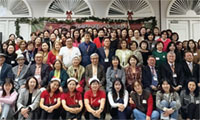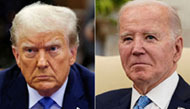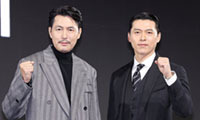Today’s Summit Meeting; Yesterday’s Pyongyang
Which leads back to Pyongyang in 1907. A long time ago, for sure, but the events happened and the memory remained for those involved in the freedom of Korea. These men and women today are not living. One name stays alive. That of Ahn Changho. His credentials are impeccable and are not lost in time. He returned from San Francisco where he organized Koreans into forming a fraternal association. It brought the scattered Koreans together, making their lives easier jobwise and their living conditions bearable. Koreans learned to help each other, to share their problems. It was a cooperative venture. Ahn Changho led families to Pachapa camp, in Riverside, California. Pachapa camp worked successfully until the failure of the orange crop in 1913, but the ten years was proof the experiment worked. Koreans lived their lifestyle, cooperatively. Now in his homeland, he pointed out cooperation was imperative if the country was to be free. Local business people heard and heeded. His grandson, Philip Cuddy, noted of this 1907 visit: (Ahn Changho) — "Returns to Korea via Tokyo. Moves audiences with patriotic speech at the Taeguk Institute, a Korean student organization, while staying in Tokyo. Organizes the New Peoples’ Association, a secret organization, with Kap Lee in Seoul. Establishes the Daesung Academy in Pyongyang; Taeguk Bookstore in Pyongyang, Seoul and Taegu; the Masandong Ceramics Factory in Pyongyang. Interview with Hirobumi Ito, rejects his offer to form a cabinet."
There was a 16-year-old student in Pyongyang, who came to hear the Korean leader, with other students. His name was Choon Har Kim. He and the others listened to Ahn’s stern warnings, his voice eloquent and stirring. His message was always the need for cooperation at every level of Korean life, and patriotic discipline in face of the coming Japanese takeover of their country. The 1905 Portsmouth Treaty was the go-ahead signal. Kim told how he and the students followed Ahn Changho’s movements even when he went swimming in the Tadong River. He said their idol was a fine swimmer, and had a fine figure. Then Ahn Changho left the city to tour the country, giving never-ending talks for the next few years he was there. He had to leave with the annexation, 1910.
Choon Har finished his schooling at the Christian academy, founded by the Presbyterians; the Kims were Christian. The Japanese were surveying every inch of the ground in Pyongyang. Kim was curious to learn what surveying meant and went to an engineering college, receiving his civil engineer’s degree. He applied to the government for a position. Of course, it was a Japanese position, and he was turned down because he was a Christian. Then he applied for a teaching post, where he taught third graders. He married; his wife bore him a daughter and then a son. He did not see them grow up. The Student Movement occurred in 1919, when he was 28 years old. He joined the young marchers as a courier in the planning stages and was deeply involved. The Japanese were after him. Kim fled to China; there he visited the provisional government in Shanghai. Support for the exiled government came from the overseas Korean, from the Koreans at home who had difficulty sending money, and Koreans in Manchuria, the largest body overseas, who were not generous, apparently having grown remote from their homeland. Kim found he could do little in Shanghai to help the provisional government and traveled north to Nanking. He was fortunate there. The head of the YMCA had a daughter in Korea who knew Kim. His name was Gillette and was from Los Angeles. He quickly obtained a visa for Kim to go to America. The year was 1924.
Kim found work immediately in Los Angeles. Koreans had opened fruitstands on the highways and there was a living in the business. He was to hold many jobs, he said, and meet many Koreans in the Korean National Association, among them Jacob Dunn and George Kim. He also learned his wife’s father was a worker in the oil fields in Taft, near Bakersfield, north of Los Angeles. Working, he found he could send his wife income to carry on in Korea. It was to be a long separation, but it was broken with a six-months visit in 1928. INS refused her an extension. It wasn’t until 1965 she was permitted to emigrate under the new immigration laws of the early ‘60s. Asked why she was so patient and long enduring, she said, her husband translating, "Only main thing (was) independence of Korea." Their experiences may seem commonplace today. Not so. Every word told was a story, a human story.
He told about his boyhood in Pyongyang. Going to school, living three blocks from there, and there to learn Hangul (Korean alphabet) and counting, singing hymns in Korean, and learning the American alphabet but no American words! In the autumn the road was cluttered with beautiful colored leaves, mostly maple trees, cedar and oak. The school division was similar to the American system, with a slight difference: elementary school was for six years, then senior high school, a missionary school and a college. All the facilities were in walking distance. And intrigued with the Japanese surveying around Pyongyang, he added the engineering school to his list of schools.
He described his life as happy and peaceful when he was growing. His father and mother were good people and everybody knew each other where they lived. Holidays were celebrated and were happy occasions. New Year’s was observed on the old-time calendar (lunar). Tano or May Day was spent at the park, with swings going up and down, and games of all kinds played by the children. Kim remembered being happy. In the fall there was Thanksgiving, it was in October. The Kims were Christian; Chusok was considered heathen by their religion. For Christians there was Christmas but not like what he was to see in America; also Easter. He recalled there was no special celebration in Korea for either events.
He still dreams of his boyhood in Pyongyang, he said, sitting in his San Fernando Valley home, talking about his Pyongyang experiences. The Kims lived in the city when families lived on farms! They grew productive foodstuff, and lived off the land. Amazing to think about today. He recalled the weather — the cold winds in November, called "Siwa", which he did not translate, not knowing its meaning. But, he said, for him it meant snowfall and skating on the ice of the Taedong River. Then there were the mountains around the city that looked like California’s low-lying foothills rising to become higher distant mountains, where big oak trees grew and pine trees which seem to be everywhere in Korea. He had not been to Diamond Mountain, the goal of all Koreans; but he read about the beautiful Diamond and loved it as he dreamed of seeing it one day, but never did. And North Korea’s own Paektu-san and its beautiful glacial lake ("Tundee", the name sounded).
He described how his parents grew rice; it was the dry farming method. The method required less work and less space. First, he said, the land was cultivated, prepared for sowing. Everything was by hand. Seeds sown by hand, dropped into furrows, where children came after the planters and covered the seeds with soil. A rainy season followed the planting; dependence on natural rainfall — without paddies — was the reason for calling it dry farming. The crop was harvested by hand. A small-handled scythe used to cut the stalks, and the rice stalks tied together and taken to the farmer’s yard for drying. There grinding machines used for separating rice from chaff ("brown part" was Kim’s expression) and was called winnowing, a process which took several weeks’ work, with everybody helping, like a cooperative team, and finally the rice stored in special barns, with the surplus sold. Rice, he said, was served with every meal; there was nostalgia in the words. Kimchee his mother made at home. But she bought the pacha from vegetable growers who, she claimed, grew better greens and radishes than did her own garden. Anyway, the pacha growers had a living to make like everyone else.
The interview with Choon Har Kim was remarkable. He spoke with so much heartfelt emotions about his Korean world. Listening to him was like listening to poetry. I had gone in search for Korean material, specifically on Pyongyangdo people. He made me glad to be born of Korean parents from the north. What we were taught in the American world was about the "gentleman of the old school", a man of integrity. Responsible, honest, decent. Not easily swayed. This was Choon Har Kim.
Choon Har Kim was born in 1891. The interview with him was taped in 1977. He was 86 years of age. His voice firm, his English often better spoken than mine. We met in his home on Fox Street in San Fernando, with the afternoon sunlight turning everything white and shining in the room. It was a shining moment. A young man came in to say he had come to take them to their doctor’s appointment. Both the people rose to greet him. Kim said, "Our grandson Michael Kim. He is County engineer, works in big white building downtown." There was pride and a feeling of accomplishment. And I remembered when Choon Har Kim explained about his son, Michael’s father, who had been an agricultural lecturer at a Seoul university when the Korean War broke, and he disappeared in the first days of the onslaught. Kim explained simply, "The Reds come and catch my boy. After that we don’t know more."
스마터리빙
more [ 건강]
[ 건강]이제 혈관 건강도 챙기자!
[현대해운]우리 눈에 보이지 않기 때문에 혈관 건강을 챙기는 것은 결코 쉽지 않은데요. 여러분은 혈관 건강을 유지하기 위해 어떤 노력을 하시나요?
 [ 건강]
[ 건강]내 몸이 건강해지는 과일궁합
 [ 라이프]
[ 라이프]벌레야 물럿거라! 천연 해충제 만들기
 [ 건강]
[ 건강]혈압 낮추는데 좋은 식품
[현대해운]혈관 건강은 주로 노화가 진행되면서 지켜야 할 문제라고 인식되어 왔습니다. 최근 생활 패턴과 식생활의 변화로 혈관의 노화 진행이 빨라지고
사람·사람들
more많이 본 기사
- 트럼프와 여성들 함께 찍힌 ‘엡스타인 사진’ 공개
- 비극 속 시민의 용기 총격범 맨손 제압
- 지구촌 또 ‘총기 난사’… 미·호주 잇단 참사
- ‘박성광♥’ 이솔이, 암 투병 중 안타까운 소식 “병원 몇 번 가는 건지..내 탓”
- 인니 수마트라섬 ‘대홍수’
- 시드니 유대인 총기참사 용의자는 50세 아버지·24세 아들
- 호주 총격범 제압 시민 영웅은 43세 과일가게 주인 아흐메드 씨
- 19개주, 전문직 비자 ‘10만불 수수료’ 소송
- 테슬라 11월 미국 판매… 4년만에 최저
- 오늘 추첨 파워볼 잭팟 11억달러로 ‘껑충’
- 워싱턴 한국학교협의회, 제37회 교사의 밤
- 통계로 본 올해 대한항공… ‘캡틴 아메리카’ 가장 많이 보고, 최다 방문지 도쿄
- 팝핀현준, 수업 중 발언 논란에 교수직 사임… “진심으로 사과”
- “성과는 있었지만 아직 끝 아냐”
- 항공기 승객정보 활용 추방 확대
- ‘아연’의 효과… 올바르게 복용하면 감기 기간 줄일 수도
- 총격 상처 피해 진학한 대학서 또 총기난사… “엄청난 타격”
- 뉴욕 백화점서 아기 기저귀 갈던 엄마, 정신질환자에 흉기피습
- [경제 트렌드] 외식비 줄이는 소비자… ‘팁 공포’ 한몫
- 안수화 회장 연임 확정
- “트럼프, 바이든 데자뷔인줄” 취임 1년새 고령 논란·지지율 뚝
- 페어팩스 고교에 폭발물 소동…10월에 이어 두번째
- 중국 ‘여행자제령’ 직격탄 맞은 일본
- 박나래 ‘링거이모’, 진짜 ‘無면허’였다 “박나래 알지만 전혀 기억 안 나”
- 아이비리그 합격 가르는 것은 ‘스펙’ 아닌 ‘습관’
- 정우성 “현빈과 텐션 점점 무르익어”…사생활 변화엔 “말씀 못 드려”
- “스마트폰 달고 사는 당신, 안구건조증 주의하세요!”
- 투고(To Go) 해야 하나?
- 연방법원, 킬마르 석방 “적법한 추방 명령 없어”
- 오늘의 베네수엘라가 내일의 동아시아국가…
- 남가주한인부동산협회, 송년모임 개최
- “걱정했잖아” 윤정수, 비 그친 발리서 ♥원진서와 신혼여행 만끽
- 백악관 연회장 신축 저지 소송 국가역사보존단체, 연방지법에
- 연말 DUI 집중 단속 무관용 강력 처벌
- ‘계엄2수사단’ 노상원 1심서 징역 2년… “계엄 동력 엄중책임”
- [이민법 칼럼] 더 힘들어진 취업이민 1순위
- 미, 베네수엘라 지상전 위협… 쿠바까지 흔들기
- 관세가 끌어올린 물가… 가구당 1,200달러 추가 지출
- 故 김지미에 금관문화훈장…마지막 말은 “보고싶다 사랑한다”
- 트럼프 관세 인하에도… 주요 식품 줄줄이 급등
- 모두가 원하는 물가 하락… 반드시 긍정적이지 않아
- 승부사끼리는 통한다…젠슨 황의 트럼프 공략 비결은
- 제트블루 여객기, 카리브해 상공서 미군 급유기와 충돌 위기
- 중, 난징대학살 추도… ‘일본군 해골 베는 포스터’도
- 퇴조의 핑크 타이드
- 존 이 시의원, 선물 수수 ‘윤리 위반’
- 미 무역적자, 5년여 만에 최저
- “마두로는 마약조직 총책”… 트럼프 속내는 석유 확보?
- 버지니아, 도로 상태‘전국 2위’…MD 13위·1위 GA
- 새 회장에 유흥태·부회장 최인환 목사 선출
1/5지식톡

-
 테슬라 자동차 시트커버 장착
0
테슬라 자동차 시트커버 장착
0테슬라 시트커버, 사놓고 아직 못 씌우셨죠?장착이 생각보다 쉽지 않습니다.20년 경력 전문가에게 맡기세요 — 깔끔하고 딱 맞게 장착해드립니다!장착비용:앞좌석: $40뒷좌석: $60앞·뒷좌석 …
-
 식당용 부탄가스
0
식당용 부탄가스
0식당용 부탄가스 홀세일 합니다 로스앤젤레스 다운타운 픽업 가능 안녕 하세요?강아지 & 고양이 모든 애완동물 / 반려동물 식품 & 모든 애완동물/반려동물 관련 제품들 전문적으로 홀세일/취급하는 회사 입니다 100% …
-
 ACSL 국제 컴퓨터 과학 대회, …
0
ACSL 국제 컴퓨터 과학 대회, …
0웹사이트 : www.eduspot.co.kr 카카오톡 상담하기 : https://pf.kakao.com/_BEQWxb블로그 : https://blog.naver.com/eduspotmain안녕하세요, 에듀스팟입니다…
-
 바디프렌드 안마의자 창고 리퍼브 세…
0
바디프렌드 안마의자 창고 리퍼브 세…
0거의 새제품급 리퍼브 안마의자 대방출 한다고 합니다!8월 23일(토)…24일(일) 단 이틀!특가 판매가Famille: $500 ~ $1,000Falcon: $1,500 ~ $2,500픽업 & 배송직접 픽업 가능LA…
-
 바디프렌드 안마의자 창고 리퍼브 세…
0
바디프렌드 안마의자 창고 리퍼브 세…
0거의 새제품급 리퍼브 안마의자 대방출 한다고 합니다!8월 23일(토)…24일(일) 단 이틀!특가 판매가Famille: $500 ~ $1,000Falcon: $1,500 ~ $2,500픽업 & 배송직접 픽업 가능LA…
케이타운 1번가
오피니언
 옥세철 논설위원
옥세철 논설위원오늘의 베네수엘라가 내일의 동아시아국가…

퇴조의 핑크 타이드
 조지 F·윌 워싱턴포스트 칼럼니스트
조지 F·윌 워싱턴포스트 칼럼니스트 [조지 F. 윌 칼럼] 대통령의 전쟁수행권
 조옥규 수필가
조옥규 수필가 투고(To Go) 해야 하나?
 신경립 / 서울경제
신경립 / 서울경제 [만화경] ‘뒷마당’ 찾겠다는 트럼프식 먼로주의

22기 LA평통 출범에 거는 기대

연말 시즌 사기·범죄 경계해야
 메건 매카들 워싱턴포스트 칼럼니스트
메건 매카들 워싱턴포스트 칼럼니스트 [메건 매카들 칼럼] 장편영화의 마지막 챕터인가
 김미선 서북미문인협회 회장시인
김미선 서북미문인협회 회장시인 [한국춘추] 하늘을 계산한 사람들, 칠정산
1/3지사별 뉴스

“마약밀매·인신매매 등 국제범죄 척결” ‘국토안보 태스크포스’ 뉴욕지부 출범
연방 국토안보부가 10일 ‘국토안보 태스크포스’(HSTF) 뉴욕지부를 출범시켰다.HSTF는 마약 카르텔, 인신매매, 자금세탁, 갱단 등 국제범…
‘오바마케어 보조금’ 올해 말 종료 가능성 ↑ 커져

워싱턴 한국학교협의회, 제37회 교사의 밤
재미한국학교 워싱턴지역협의회(회장 정광미)가 13일 ‘제 37회 교사의 밤’을 개최, 한 해 동안 헌신한 교사들의 노고를 위로했다. 올해 최우…
안수화 회장 연임 확정

총격 상처 피해 진학한 대학서 또 총기난사… “엄청난 타격”
고교 총격 사건 생존자인 미아 트레타가 브라운대 총격 사건 이후 인터뷰하는 모습. [로이터]동부 브라운대에서 총격 사건으로 10여명의 사상자가…
내년 중간선거 낙관못하는 트럼프… “경제성과 전달에 시간 걸려”

오늘 하루 이 창 열지 않음 닫기 





















































.png)


댓글 안에 당신의 성숙함도 담아 주세요.
'오늘의 한마디'는 기사에 대하여 자신의 생각을 말하고 남의 생각을 들으며 서로 다양한 의견을 나누는 공간입니다. 그러나 간혹 불건전한 내용을 올리시는 분들이 계셔서 건전한 인터넷문화 정착을 위해 아래와 같은 운영원칙을 적용합니다.
자체 모니터링을 통해 아래에 해당하는 내용이 포함된 댓글이 발견되면 예고없이 삭제 조치를 하겠습니다.
불건전한 댓글을 올리거나, 이름에 비속어 및 상대방의 불쾌감을 주는 단어를 사용, 유명인 또는 특정 일반인을 사칭하는 경우 이용에 대한 차단 제재를 받을 수 있습니다. 차단될 경우, 일주일간 댓글을 달수 없게 됩니다.
명예훼손, 개인정보 유출, 욕설 등 법률에 위반되는 댓글은 관계 법령에 의거 민형사상 처벌을 받을 수 있으니 이용에 주의를 부탁드립니다.
Close
x